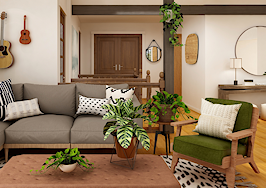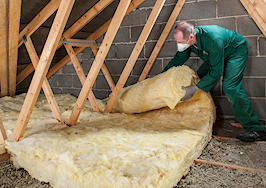Old homes are often praised for their character, while new homes are more likely to be seen as “cookie cutter” replicas.
The housing market has been roaring over the past several months of the coronavirus pandemic, so what kinds of homes are optimal for living and working at home through stay-at-home orders and social distancing? It may depend a lot on lifestyle and what kinds of things a buyer is willing to put up with.

Michelle Drum | Gustav White Sotheby’s International Realty
“Certainly, with the historic home, you’ve got lots of charm, you have a lot of character — they’re all unique,” Michelle Drum, associate broker at Gustave White Sotheby’s International Realty, told Inman. Drum is a specialist in coastal and historic properties in Newport, Rhode Island, and she herself, along with her husband and dog, live in an 18th-century schoolhouse.
During the pandemic, many homeowners who were considering updating their segmented, “old-fashioned” home with a modern, open concept likely reconsidered once it became apparent that the whole family would be staying at home together for the long haul.
“There are different types of historic homes in Newport, Rhode Island, and certainly [on] the East Coast, [there are] mainly colonial homes, so you don’t have the open floor plan,” Drum said. “Which, ironically, in the day of COVID, I think people might be getting away from the open floor plans so that they can have some space to do Zoom meetings or have some privacy. So, I think for that reason, with this sort of changed world, historic homes, and that factor, have a level of value.”

Many historic homes in Newport, Rhode Island, feature single-pane windows, fireplaces, and segmentation of the home through multiple rooms | Credit: Realtor.com
Drum told Inman that Newport, her primary market, has one of the largest inventories of antique homes in the country because unlike many other major U.S. cities, Newport never suffered from a significant fire that destroyed many historic homes in places like San Francisco, Chicago and New York. The city also fell into poverty after the Revolutionary War, so there’s never been a lot of new development in the area to replace historic homes. As a result, Newport has numerous pre-revolutionary and just post-revolutionary homes, while neighboring Providence is plentiful in Federal style homes from the 1820s and ’30s.

Cathy Franklin | The Corcoran Group
In New York City, Cathy Franklin, an agent with Corcoran Group, said pre-war homes built before 1945 have found new appeal as people stay at home more often.
“Definitely, I’m finding that,” Franklin told Inman. “[Pre-war homes have] the potential to have a huge kitchen, beautiful high ceilings, wood-burning fireplaces. I don’t know what you’re seeing, but we’re seeing so many people want wood-burning fireplaces probably because they spent half the winter indoors this past year, cooking and hanging out. Pre-war apartments and townhouses in New York tend to have higher ceilings, they tend to have wood-burning fireplaces, they tend to have phenomenal architecture, great moldings, white oak herring bone floors, that you just can’t replicate the way that they were originally built at that time. Bigger windows [too].”
Over the course of the pandemic, Franklin said her adult children and their friends have taken to alternatively working from and sheltering in the family’s 1806 Georgian home in the Hudson Valley, as well as their spacious 1886 townhouse in the city.
“So, both are historical homes and both have lots of space,” Franklin said. “Think about it — a townhouse has multiple levels, you have a garden, you often have a terrace, sometimes you have a roof deck, if you’re lucky you’ll have a basement that’s been excavated. So it allows for a lot of people to be in a space and to work from home, educate, Zoom from home, have your dog go outside …”
Robbi Correa, a Realtor with Duck Realty in Palatka, Florida, told Inman the majority of historic homes in her market were built in the early 1900s, and are largely craftsman bungalows with a few Victorians mixed in. Therefore, these older homes tend to have attractive features like sizeable porches, high ceilings, and sometimes, transom windows — all features that promote air circulation, and are no doubt invaluable now during this pandemic as people try to avoid a virus transmitted through airborne particles.

Victorian-era homes like this 1909 property in Palatka, Florida, often feature a porch and transom windows | Credit: Realtor.com

Robbi Correa | Duck Realty
“They pretty much all have porches, but if you’re in the Victorian era … they could be a wraparound, but they’re not going to have the same features of styles of columns and design that a craftsman might have,” Correa said. “The other feature that’s pretty consistent through both architectural periods is the very high ceilings before the advent of central air. They were built with high ceilings so that the air could circulate and the heat could rise during the summer.”
“I have a small Victorian cottage, it was built in 1898, but it has 12-foot ceilings and has transom windows over the doors throughout the house, which again, was another air-circulating feature,” Correa added.
For individuals who have craved more fresh air and time outdoors during the pandemic, midcentury homes built between the late ’40s to early ’70s offer a lot of features that attempt to merge indoor living with the nature outside, TJ Pierce, owner/operator at Midcentury Homes by Anthology, told Inman.
Homes built in Pierce’s target market in Boise, Idaho, typically date back to the ’50s and ’60s, and boast features like clerestory windows, which are situated at the top of a home’s wall, allowing natural light and a peek at nature, while still affording privacy. Although it’s not as common in the homes in his market, Pierce said a segment of homes in the area have floor-to-ceiling glass windows either in an interior atrium or the backside of a property, which also encourage interaction with nature.

This 1959 home designed by Art Troutner in Boise, Idaho, is abundant in large windows that bring the outdoors inside | Credit: Zillow
“It’s trying to eliminate this line or division of indoor to outdoor,” Pierce said. “It actually wants to try to blur those lines, so if you’ve got floor-to-ceiling glass, your interaction between the two spaces of indoor to outdoor living starts to blur, which gives you a little bit better sense that your home might actually feel and operate bigger than the square footage that it’s technically listing on paper.”

TJ Pierce | Midcentury Homes by Anthology
Similarly, many midcentury homes are single-level, and oftentimes have more doors that access the outdoors, which can also give the illusion of more space. These homes also tend to be very simple and minimalist, and feature custom built-ins, both of which may welcome to pandemic-era homeowners.
“Things are really complicated and confusing and busy, so if you can bring some simplicity to the home, that’s oftentimes celebrated,” Pierce said. “A perfect example is custom built-ins to a home. In a lot of these other styles or eras of a home, you have to bring furniture in, which then starts competing with your square footage, but if you have a built-in closet or cabinet in a bedroom or even in a living room … it still allows for maximizing your livable square footage without having to bring in furniture.”
But living in a historic home isn’t all daydreams of life in a simpler time. They require a lot more maintenance than newer homes, and may have particular features that don’t appeal to the modern day homeowner already coping with a pandemic. With a new home, on the other hand, buyers benefit from the peace of mind of not having to worry about looming repairs until years down the road.
“It’s a never-ending labor of love,” Drum told Inman. “I think it’s certainly a lifestyle choice. Either you love living in an antique home and you’re willing to take it on, or you just want new construction, which is maybe not always as imaginative, but at least is straightforward.”
Drum noted that with the historic homes in her market, it can be quite difficult to heat them since many have single-pane windows and are post and beam construction, or “balloon frame,” homes, which can’t be insulated. Although many have multiple fireplaces meant to help heat the house, cold air can actually rush down into the home through the chimney, making regulating the temperature challenging.
“I think heating costs are certainly … of concern, and it doesn’t take much for an antique house to get cold and you have to have somebody sort of monitoring it,” Drum said.
In addition, plumbing and electric are usually quite delicate in these homes, and even if the electrical system has been updated, there could still be some older wiring present within the house, which could be potentially risky.
Correa noted that it can also be a challenge to find workers who are qualified to conduct necessary repairs on historic homes.
“It is difficult to find skilled tradespeople that have knowledge about historic rehab if you are going to look for people to help or pay to assist you,” she said. “And once you start a project, you never know what you’re going to find underneath. So something that seems minor at the onset could end up being a major production.”
In the midcentury homes that Pierce usually works with, he noted that features like squeaky hardwood floors and galley kitchens could drive families crazy while sheltering at home now during the pandemic.
“If you’re at home dealing with nap schedules, one wrong step can affect your whole day if that kid ends up waking up post nap from a hardwood floor that creaked a little too loudly,” Pierce said.
“And galley kitchens were really great for Betty who sat in the kitchen and prepared food for the rest of the family all day, but that’s not how families live today,” he added. “I’m 6’6″, my son’s 6’2″, my other two daughters are 5’9” plus, and those giant human beings in a galley kitchen all at the same time give quite the ping-pong affect. And that can be frustrating, especially if they’re at [remote] school and they’re needing to do lunch and we’re at home working having to do lunch, and we all have this 30 to 45-minute window where we need to accommodate feeding ourselves.”
Whichever way a buyer goes — old or new — the solution may simply be to mentally prepare for whatever possibilities may lie ahead with their new home during this pandemic winter, for better or for worse.













